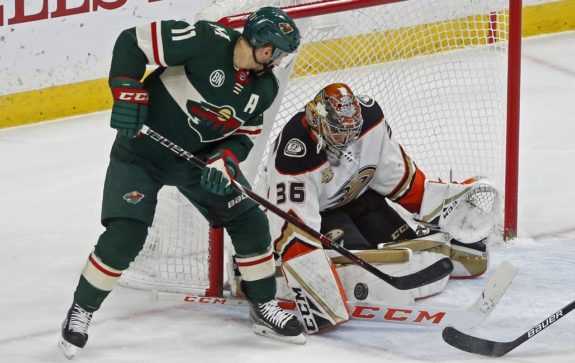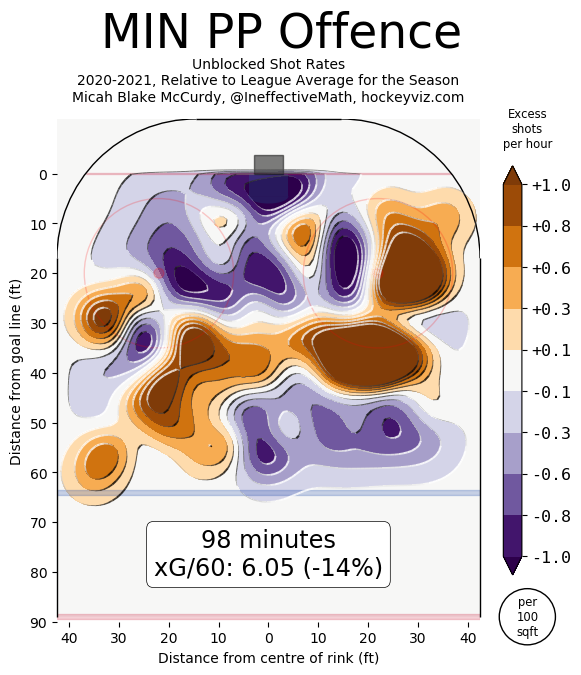The Minnesota Wild’s power play struggles will become increasingly problematic real fast, as if it hasn’t already become a barrier. It has been an issue all season, and nothing has changed. While the Wild are one of the best even-strength teams in the league, it is important to have a quality man advantage that can inevitably help secure more wins. For a roster that lacks talent, it is critical to capitalize on an important facet of the game like the power play.
The Wild have scored five power play goals this season on 55 attempts, which is a fair representation of how poor the man advantage has been thus far. The Wild rank seventh in ice time on the power play, so the lack of production hasn’t been due to a lack of opportunities. Let’s examine the issue, questionable deployment, concerning trends, and the broken system that plague the Wild’s inconsistent and inadequate power play.
Prominent Issues Surrounding the Power Play
The Wild’s 3.97 goals for per hour on the power play ranks 28th in the NHL. This is a significant plunge from their 7.79 in the 2019-20 campaign that ranked 10th league-wide. One of the facets of the Wild’s man advantage that has seen a distinct change from last season was their finishing, or lack thereof. Their 5.71 expected goals for per hour in the 2019-20 season displayed the Wild’s elite finishing ability. The Wild scored 2.08 more goals per hour than expected, and their 15.63 shooting percentage on the power play was fourth in the NHL.
This is one of the distinct differences between last season and now; the Wild lost their finishing touch, which could likely be due to abnormal finishing from Zach Parise and Kevin Fiala last season. It also was affected when they lost two prominent shooters in Jason Zucker and Eric Staal too. Fast forward to this season, the Wild’s 6.15 xGF/60 ranks 25th in the NHL, which is on par for last season’s number of 5.71. The Wild’s GF/60 this season is on par with their xGF/60, which is an issue for a team that significantly outscored their expected goals last season.
The distinguished complications surrounding the Wild’s abysmal power play this season is a lack of finishing and generation of quality scoring chances in comparison to the numbers league-wide. They will have to figure these elements out in order to improve their scoring rate on the man advantage.
Questionable Deployment
Similarly to former Minnesota Wild head coach Bruce Boudreau, Dean Evason has given too much ice time to several of the veterans on the roster. Ryan Suter and Zach Parise are second and third, respectively, on the team in ice time on the man advantage. But both of them have been poor on the power play so far this season. Parise and Suter have been two of the worst players on the Wild this season, which makes this deployment very questionable.
It makes sense why Evason deploys them so much because of the elements they bring to the table. Parise has made a career out of being a net-front presence. He scores a majority of his goals close to the net, which is a valuable asset. Suter has been a power play specialist throughout his career and shoots at the net for deflections. However, if their tools aren’t improving or positively affecting the power play, it makes no sense to continue with something that evidently needs improvement.

On the other hand, it is beyond me why Nick Bonino is on the Wild’s power play. He has the fourth-most power play ice time among all forwards on the team. While he excels at faceoffs, there is nothing more to his game that stands out and benefits the Wild over other players. He has struggled all season, which is evident in his underlying numbers.
The Wild have witnessed Joel Eriksson Ek and Jordan Greenway breakout this season. They are both molding themselves into legitimate top-six forwards. It is very puzzling that they get such little time on the man advantage while there are veterans struggling that are mainstays on the power play. It would be good for their development to get an elevated role such as significant power play time.
Concerning Trend
One of the concerning trends on the Wild’s power play this season — and last season — is the location and volume of shots being taken. Like I previously mentioned above, the Wild’s power play in the 2019-20 campaign was very dependent on their ability to finish. They weren’t strong at generating offense, and that has carried over to this season, where they are still currently struggling in this regard. To make matters worse, they lost their scoring touch to a degree, which is a recipe for disaster.
Looking at Hockey-Viz’s shot map below, it displays the volume of shots being taken, the location of where they are being taken, and also shows below how many goals the Wild are expected to score per hour so far this season based on the shots that have been taken.

As shown above, on the visual, the location of shots is particularly hurting the Wild and is the pressing issue at hand. The Wild are having trouble generating high-danger chances. They generate fewer shots than league-average in the low and middle areas of the slot. Likewise, they shoot fewer shots than league average in front and around the net, aside from the small area near the faceoff circle. Furthermore, the Wild’s 28 high-danger chances on the man advantage rank 17th league-wide despite them being just outside the top five in ice-time on the power play.
While they do generate a higher volume of shots in the center of the ice at the top of the faceoff circles and the high slot, it clearly isn’t translating to goals, which is an underlying issue. This has to be fixed in order for the man advantage to be more effective. The location, volume, and quality of shots are critical for a power play to flourish.
The Wild produced shots with an average danger of 6.05 goals per hour. Their expected goals per hour is 14 percent less than the league-average power play this season. The two biggest elements that have to be fixed for the man advantage to succeed are more high-danger chances and a better finishing ability, which can vary depending on the deployment.
A Broken System
The Wild’s power play system is clearly broken and needs an overhaul. The Wild have trouble entering the zone — transition is a weakness for the team — and often find themselves having to go get the puck again after a strong breakup on an entry. The Wild have always lacked a strong transition game due to the lack of high-end talent, albeit the system behind the scenes doesn’t help it by any means.
It is hard to blame head coach Dean Evason, but when a power play is this awful, there has to be accountability, and it starts with Evason. It isn’t just entering the zone or maintaining possession, but it is also the inability to generate high-danger shots in front of the net and in the low slot. Even though the Wild do have a higher volume of shots in the center of the ice, it wouldn’t be unfair to characterize them as a perimeter team on the power play. Something has to change because this has become problematic, and frankly, is out of hand.
Final Thoughts
The Wild have to improve their power play because relying fully on even-strength is not the best recipe for success. Providing more ice time to youngsters like Eriksson Ek and Greenway on the man advantage will help them succeed and bring their game to the next level. Likewise, generating more high-danger chances and fixing the broken system will help amend the issues that are increasingly present.
Something has to change, and they need to take action because simple elements like entering the offensive zone is an attribute that the Wild are struggling to excel at on the power play.
(All Data Via Evolving-Hockey, Hockey-Viz, Natural Stat Trick & Hockey Reference)